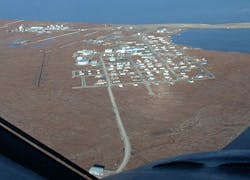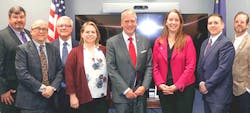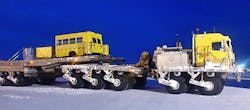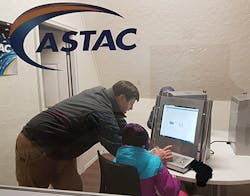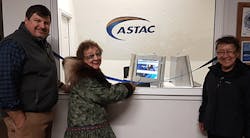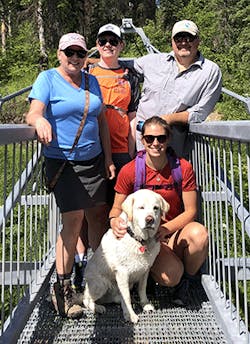Executive Insights With Jens Laipenieks, CEO/GM of Arctic Slope Telephone Association Cooperative, Inc. (ASTAC)
TOPIC: COVID-19
Sharon Vollman, ISE: How has the coronavirus (COVID-19) pandemic impacted your company, customers, AND team members?
Jens Laipenieks: The pandemic has significantly impacted all aspects of our Cooperative. Fortunately, we were well prepared to make the shift to work from home even before the rollout of the official hunker-down orders hit Alaska. Our corporate strategy over the past few years has included investments to modernize and automate wherever feasible. A few years ago, we transitioned entirely to Office365 and fully adopted Microsoft Teams and SharePoint as our internal comms platform. We had also updated our VPN platform and phone system to enable a fully decentralized call center and workforce. These investments allowed us to quickly adapt to COVID-19 and to continue to evolve as our needs change.
The entire ASTAC team, from leadership to field technicians, has stepped up to every challenge COVID-19 has thrown at us. In many ways, the pandemic has proven ASTAC’s ability to be nimble, creative, and remain customer-focused, all while protecting the health and wellbeing of our employees.
ASTAC Executive Team, August 2019. (L to R) Stacy Marshall, Director of Customer Experience; Charlie Carpenter, COO; Luke Middle, Chief Network Officer; Megan Clapper, HR/Office Manager; Brian DeMarco, Chief Network Officer; Jens Laipenieks, CEO/GM; Thomas Lochner, Director of Business Development/Sales; Clover McNeil, CFO.
ASTAC’s members are our top priority, which is the most special part of working for a Cooperative. ASTAC joined the FCC’s Keep America Connected Pledge almost immediately, and quickly launched an Internet service credit for those working and learning/teaching from home. Like all ISPs, we saw our network usage jump; the peak hour traffic graph spread from 5-6 hours to about 20 hours per day. We were fortunate to benefit from the generosity of our underlying Middle Mile provider who gifted us increased capacity during the surge.
Leading the Cooperative through this pandemic has been one of the most challenging tests of my career. Although we had a Disaster Recovery (DR) plan and numerous contingencies in place, a pandemic playbook simply did not exist. My greatest concern was wedging myself at the tip of the decision-making funnel. In the first few weeks, there was so much different information and guidance coming in that it became unmanageable.
The solution I crafted and launched was a COVID-19 Response Team, with a Response Leadership Team and various Action Teams. The individual action teams (External Communications, Regulatory Support, Supply Chain, Financial Modeling, Technology and Network) were all given the power to assess and react as needed and immediately. Over-communication became the expectation, decisions were shared, and our regular Response Team meetings continue today.
TOPIC: CO-OPS AND NETWORK TRANSFORMATION
ISE: What is the most challenging thing about working to transform ASTAC’s network as a co-op? What is the greatest benefit to being a co-op?
Laipenieks: To understand the challenges ASTAC faces, you must first understand the landscape of the North Slope. Our serving area is immense, over 90,000 square miles, with a population of ~9,500. That is about 10 sq. miles per person. Imagine the landmass of Minnesota, with one dirt road to access a tiny part of it, the rest unreachable by road. The only access to most of the ASTAC communities is by small plane or once-per-year barge service.
Unlike much of rural America, the homes in the villages of the North Slope of Alaska are not spread out, but the villages themselves are. The difference between remote vs. rural is a conversation I have frequently when visiting Washington, DC, and at industry events. The remoteness and frozen tundra make building extensive roads cost-prohibitive — and roads are what enable affordable broadband expansion across the rest of Alaska.
Aerial view of Kaktovik, Alaska, pop. 256. (Photo Credit: Department of Commerce, Community and Economic Development; Division of Community and Regional Affairs’ Community Photo Library)
L to R: Jens Laipenieks, CEO/GM, ASTAC; Jeff Smith, VP– Regulatory Affairs, GVNW Consulting ; Bob Dunn, Director of Regulatory Affairs, TelAlaska; Juliana Wayman, Senior Director of Regulatory Affairs, GCI; U.S. Senator Dan Sullivan (R-Alaska); Christine O’Connor, Executive Director, Alaska Telecom Association; Ryan Ponder, Director of Legal & Regulatory Affairs, Matanuska Telephone Association; James Dunn, CEO, Copper Valley Telecom.
ASTAC has spent the last 5 years upgrading our Last Mile networks to fiber. Today we reach almost 90% of our population with a fiber connection, and by 2020 year-end, nearly 100% with 4G LTE wireless service. This, in and of itself, is a huge accomplishment.
But the greatest challenge we face as a Co-op is not owning the Middle Mile connectivity to the Internet. The ability for us to deliver truly transformational bandwidth to our membership depends on the affordability of this critical link. We may have the most state-of-the-art Fiber-to-the-Home (FTTH) networks capable of Gbps speeds, but the economics of our Middle Mile force us to limit our broadband offerings to a mere 10 Mbps with metered service, which by comparison to any road-connected markets, are very, very expensive.
The greatest benefit of being a Co-op is that we can manage our margins to keep our products affordable. We can also extend our ROI thresholds as we consider the high CapEx cost of expanding our networks and connecting our markets. We remain accountable to our membership, with a mantra of equality for all markets, and not to investors who seek higher and shorter-term returns.
TOPIC: PAIN POINTS
ISE: ASTAC offers about 4K access lines across a roadless, remote arctic area of more than 90,000 square miles –this area is larger than 40 of the 50 states. What are your biggest challenges/obstacles to delivering higher speeds to those customers?
Laipenieks: Delivering higher speeds is not the right question. The real question should be how to deliver affordable high-speed services to our customers. The majority of the North Slope population is not wealthy, with an average income of $47,000-$58,000. The largest businesses are native corporations and the different divisions of the North Slope Borough government.
Everything in the Arctic costs more. Gas, $5.50/gallon; milk, $10/gallon; travel from Anchorage to the North Slope, $750; intervillage airfare, $400. ASTAC’s cost of operation is greater than anywhere else in the US.
We also have a large number of transient staff. All our field techs work 3-weeks-on/3-weeks-off shifts, 21 ten-hour days with OT built in. ASTAC also provides transportation from Anchorage and room and board. All these factors drive up our cost of service, which are compounded by the very high cost of monopolistic Middle Mile transport (discussed earlier). These are the greatest challenges to delivering truly transformational and affordable broadband speeds to our membership.
TOPIC: SUPPLY CHAIN
ISE: What are the biggest issues your team faces related to supply chain? Are there some suggestions you have for the vendor community to help remedy these challenges?
Laipenieks: Supply chain challenges are a bit of a minefield considering we are serving the most remote parts of a very remote state. There are only 2 airports with commercial jet traffic on the North Slope: Utqiaġvik and Deadhorse. The overland trip is 890 miles from Anchorage to Deadhorse over the gravel road made famous by the TV show Ice Road Truckers, the Dalton Highway. It would take ~20 hours if you were to drive it nonstop. The road can be extremely hard on cargo when the road is muddy, wash boarded, or frost-heaved, which is much of the year. This is especially true for electronic gear, which is not generally packed to sustain such abuse in transit. To mitigate this, we establish clear guidelines with our vendors of what can be shipped by truck and what must be shipped via air cargo. We generally have materials shipped into Anchorage and then re-shipped to ensure accuracy, timeliness, and special handling are considered. We also stage materials for specific projects so we can ensure that all components and adequate spares are accounted for before shipping to the field.
Transporting job materials to midway job site, west of Nuiqsut via Rolligon.
Order accuracy and attention to detail are imperative for both ASTAC and our vendors. Ordering or delivery of the wrong part can mean months of delay and added expense. Intermittent mail delivery in the North Slope villages also adds to the logistical challenges. I recall a case where a village went months without a local postmaster. Since there is no local mail delivery, every recipient has a P.O. Box and has to arrange to pick up mail. Without a postmaster, the mail just sits. Close communication between our purchasing staff and our vendors is key to reducing our supply chain issues.
TOPIC: SERVING THE UNDERSERVED
ISE: Given the current environment, it is no longer optional to allow our citizens to struggle with sub-par, asymmetrical bandwidth speeds. What is ASTAC doing about this?
Laipenieks: Closing The Digital Divide is at the core of ASTAC’s mission. For many years we stood still while the connected world accelerated away from us. Before the Quintillion fiber network launch in December of 2017, our only option was satellite service. Around 2012 we transitioned from grossly expensive satellite T1s to painfully expensive satellite Ethernet service. This improved our economics just enough to offer 1Mbps DSL service. Although a huge improvement over our legacy dialup service, we still had to be significantly oversubscribed to achieve a break-even proposition. The demand on our networks steadily increased as Internet adoption grew, and the reality of our unlimited use products became clear.
In late 2017, we launched our metered Home Internet product with 10/3 Mbps service served over our new fiber Last Mile with Calix Gigacenter CPE with Wi-Fi built-in. We continue to add capacity to support demand on both our wireline and wireless networks, but the economic balancing act will continue for the foreseeable future.
As of today, 4 of our 9 markets remain on satellite backhaul. This is where we have placed a bullseye. Our long-term plan is to connect all our members to a terrestrial network that can scale to meet the demands of the future. Satellite simply will not suffice. For every day that goes by, The Digital Divide widens for these "final four" markets as 5G and Gigabit smart communities proliferate across the country.
TOPIC: CULTURAL TRANSFORMATION
ISE: Explain why cultural transformation is as important as technical transformation to ensure Communications Service Providers like ASTAC succeed in the "new normal".
Laipenieks: This is a sensitive question for me. About 70% of the population of the North Slope are Alaska Native. Maintaining the strength and respect of the Inupiat culture is critical for ASTAC. Technology and cultural values do not have to be at odds. Sit in any room with a group of teenagers and it is easy to see how technology is impacting and evolving many facets of their lives. It’s no different on the North Slope. Providers like ASTAC have a responsibility to promote and encourage the benefits of broadband, and I’m not talking about just gaming and better streaming service. We are making investments and developing partnerships to enable new opportunities for the Inupiat culture to grow and remain strong.
Jens unveiling Point Hope Alaska Community Activities Center computer kiosks.
Point Hope Alaska Community Activities Center kiosk unveiling with (L to R): Jens Laipenieks, CEO/GM, ASTAC; Board member Ella Kowunna; Mayor Daisy Sage.
ASTAC’s scholarship program awards four $2,000 scholarships to 2 senior high school students and 2 students currently enrolled in post-secondary education from our serving territory.
As the sole supporter of the North Slope Borough School District’s Battle of the Books program since 2015, ASTAC has helped grow the program each year, increasing the number of students taking part. We believe in the goals of this nationwide program which include encouraging and recognizing students who enjoy reading, broadening their reading interests, increasing their reading comprehension, and promoting academic excellence.
In addition, ASTAC believes in inspiring science and technology leaders of tomorrow. Our support of the NSBSD’s FIRST Lego League (FLL) has helped expand the robotics program from middle school to also include K-4 and high school students. FLL’s objective is to make children and youngsters enthusiastic about science and technology; equip them with the idea of team spirit, and to encourage them to solve complex tasks in a creative way.
During robotics tournaments, participants must solve a tricky mission with the help of a robot. They research a given topic within a team, and develop a plan for programming and testing an autonomous robot to solve the mission. The FLL Teams have the opportunity to experience all steps of a real product development process: solving a problem under time pressure with insufficient resources and unknown competitors.
In 2021, ASTAC will host its first annual Alaska Business Week in Utqiaġvik for high school students. The week-long program teaches students the basics of business, leadership, and entrepreneurship. Participants compete as teams in a dynamic business simulation with the guidance of adult mentors from the business community. After completing the program, students have a competitive edge on workplace readiness, college preparation, and overall life success.
InvisiLight® Solution for Deploying Fiber
April 2, 2022Go to Market Faster. Speed up Network Deployment
April 2, 2022Episode 10: Fiber Optic Closure Specs Explained…
April 1, 2022Food for Thought from Our 2022 ICT Visionaries
April 1, 2022TOPIC: PRIORITIES
ISE: What are ASTAC’s 2020-2021 priorities? What will move the needle in terms of network transformation for your company? Network simplification / automation / virtualization? Fiber investments? AI/AR?
Laipenieks: Our priorities are simple: to connect everyone on the North Slope to terrestrial, high-quality broadband networks. We have completed FTTH builds in 5 of our 9 markets, with Utqiaġvik being the largest and most complex build. We were in the final stages of customer conversions when the COVID-19 pandemic hit, so we still have some work left to do there. Our FTTH cookie cutter is sharp, and we intend to convert all 9 of our markets. We are also finishing up a few LTE carrier additions to get our wireless network 100% LTE. A handful of these sites are along the northern half of the Dalton Highway, which will bring new 4G coverage to the most remote road in America.
Beginning in 2021, we will focus on projects extending fiber or microwave connectivity to 2 of our "final four" markets. One of those projects connects the village of Atqasuk, about 65 miles due south of Utqiaġvik. Our connectivity plan includes a combination of aerial and ground-layed armored fiber, a novel and more cost-effective alternative to traditional buried fiber. In early 2020, we were awarded a USDA Community Connect grant which helped make this project a reality. We are also finalizing plans for a microwave expansion to connect the village of Kaktovik, about 70 miles west of the Canadian border on the coast of the Beaufort Sea.
We have been pushing system integration and automation as a company-wide goal since I took over the GM position in 2016. Every keystroke we can eliminate is a win from an efficiency and accuracy standpoint. We are also driving to get 100% of the copper plant removed in our fiber-fed markets by YE 2021 to ensure we have little to no variation in our systems and procedures.
TOPIC: TECHNICIANS
ISE: Share how your field techs’ methods and procedures have changed given the COVID-19 environment. How do you train your techs in both hard and soft skills so they can remain safe while being the face of your company to customers?
Laipenieks: Our operations staff adapted very quickly to the changing COVID-19 situation, and, as essential workers, we were required to develop and submit our operating plan to the State of Alaska Department of Commerce, Community and Economic Development. That plan detailed how our technicians would safely commute into Deadhorse and Utqiaġvik for their shifts and interact with our customers.
ASTAC employs both resident and non-Alaska resident technicians. Because of the mandatory 14-day quarantine for interstate travelers, we allowed some techs to work remotely on projects, record updates, and online training, while many of the Alaska-based techs extended shifts to cover the workload. We also have resident Village Reps in each of our remote villages who have stepped up to solve problems and provide remote support when needed. This allowed us to greatly reduce the need for village travel and thereby reduce the possibility of spreading the virus.
In mid-March, our COO, Brian DeMarco, instituted a recurring meeting with all operations staff to discuss the changing protocols and coordinated ongoing training with our Exchange Managers. The training emphasized how to mitigate interaction risks with customers if we need to enter homes or businesses as well as encouraging the use of understanding, patient, and consistent, dialog with our customers, and adherence to any specific business customer’s protocols. Normal scheduling intervals were loosened to allow maximum flexibility for our customers and to de-stress our techs.
TOPIC: PUBLIC-PRIVATE PARTNERSHIP (P3) MODELS
ISE: Are P3 models the best way to connect underserved areas across America? Why or why not? What are alternative models that might be better?
Laipenieks: Yes! P3 programs like the USDA’s Community Connect and the Re-Connect programs are instrumental in making the business case for the Middle Mile expansions required to connect all Americans. Both programs require the applying carrier to have a significant amount of skin in the game and plenty of checks and balances to receive distributions. Both programs require specific service targets (25/3 Mbps) and free access to community centers and anchor institutions.
The Alaska Plan, which replaced the traditional USF support model for most carriers in Alaska requires specific performance obligations for the expansion of broadband in underserved markets. I believe in the concept of Universal Support, — without it, ASTAC would likely not exist. To be most effective, all recipients should show progress and be accountable for responsible stewardship of the funding.
One way to improve the USDA’s Community Connect and the Re-Connect programs would be to mandate a cost-based rate structure with a fixed maximum return that would eliminate the opportunity for the supported carrier to gouge the market and deter competition. I would also like to see federal and state mandates for expedited land use and ROW permits for publicly funded broadband expansion projects. The compounding costs and delays related to the excessive bureaucratic permitting process are a waste of scarce resources, and should be reduced as much as possible.
TOPIC: NUTS AND BOLTS
ISE: Given the terrain you cover, share your favorite story about this challenging situation in which your team members went above and beyond to serve customers’ needs.
Jens splicing fiber.
Laipenieks: We began our first FTTH project in the village of Point Hope in 2015, and we have grown more efficient and cost-effective with each village we’ve converted since. Two events come to mind that exemplify the creativity and adaptability of the ASTAC team.
The first was related to the fiber cable needed for our Point Hope and Wainwright builds. The logistics of these remote builds were incredibly challenging. Keep in mind there are no industrial supply stores or even hardware stores in these markets, so you must bring EVERYTHING, including supplies for contingencies.
In this particular case, we had a hard deadline for the barge leaving Tacoma, Washington, and at the last minute, we were notified that our spools of fiber cable had been delayed because of the excessive demand for fiber optic cable in the lower 48 (Thanks, Google Fiber!). With only 1 barge and the very limited building season in the Arctic, we were faced with an entire year delay.
With some ingenuity, we were able to finally get the cable weeks later and have it trucked to Anchorage. We then loaded it into a C-130 Hercules cargo plane from Lynden Air Cargo which is capable of landing on the gravel airstrips in the villages. I don’t like to think about the added cost of that charter, but the fiber arrived in the market with the barge about 8 weeks later, and the projects stayed on track and were completed before winter set in.
The other instance was just straight up ingenuity. In our first few FTTH builds, we utilized aerial fiber terminals, and soon realized that in the harsh winter with the large snow piles, it became a challenge to get a bucket truck into proper position to pull the cases down for splice work. Our Project Manager, Nate Yaskell, did some research with another Alaskan Co-op, and applied a twist to their practice of pole mounting the fiber terminal with a slack loop so a single tech with a ladder could easily pull the case year-round. The Utqiaġvik project included over 400 of these O&M-friendly pole-mounted terminals.
TOPIC: THE FUTURE
ISE: What emerging or disruptive technology excites you the most for the ICT industry? Why?
Laipenieks: The future! Our markets are still about a generation behind on overall adoption, so for ASTAC just catching up to today’s urban/global application set would be exciting. I am also very interested to witness all the new and creative applications and "new normal" use cases as we emerge from COVID-19. We recently had our first-ever virtual Board of Directors meeting via WebEx, and it was awesome. Even over the slower, higher latency satellite connections, we were able to conduct our business and engage as usual.
All the hype around 5G is hard to sidestep, but the high cost of backhaul will continue to be our barrier to adoption on the North Slope. That being said, if and when we achieve capacity economics, our fiber networks will be more than capable to support the densification and higher transport speeds of 5G.
High-speed connectivity and innovative technologies will no doubt be an integral piece of supporting our North Slope communities as they navigate the effects of global climate change in the future. The proliferation of advanced IoT sensors will generate more real-time data from the changing climate.
ASTAC supports a variety of research institutions on the North Slope, and we continue our efforts to close The Digital Divide and to aid these communities in preserving their way of life well into the future.
TOPIC: ENTREPRENEURIALISM
ISE: Tell us the story of how and why you came to lead ASTAC. Share the advantages and disadvantages to leading your team of 77 in this environment.
Laipenieks: My telecom career has been stochastic at best. My trip to Alaska in 1994 was intended to be 24 adventure-filled months of fishing, kayaking, and snowboarding, before an earnest pursuit of a career. I had prior experience running small businesses, and I stumbled into a temporary Junior Accountant position with the municipally owned telephone utility in Anchorage. That role became permanent, and I found my way into a plant accounting position that led to a lead role in a series of SAP (financial system) implementations. I was focused on budgets, capital projects, and fixed assets, but the job spanned all aspects of the company’s operations.
Looking back, those few years were a bit of a death march, as most system migrations are, but they were also the most critical in my telecom development. When you fully understand the entire back office, all the ins and outs, workflows, datasets, best practices, and finally FCC accounting and reporting, you develop a knowledge base that cannot be learned in the classroom.
I had 9 different jobs over the 16 years at that company before I made the change to ASTAC. At that time, I had 2 young kids, and the Co-op offered me the life balance that I needed.
The sales/business development and operational management experience at ASTAC rounded out my skill set to take on the CEO role.
I’d say the greatest advantage is knowing how all the parts fit together to make the company work — every job, and every financial transaction. In the current environment, managing our spending and re-forecasting our financial models has been our priority, so this understanding is very beneficial.
I have built a very strong leadership team at ASTAC, and I am confident that our combined experience and commitment to open and frank communications will see us through the next chapter of the Co-op and my career.
The disadvantage we all face is simply all the uncertainty and requisite crystal balling of the next 24-36 months. There are no historical models of pandemics to build from, which is compounded by the fact that the majority of the economy of the State of Alaska is so heavily tied to tourism and the oil and gas industry, and the tax revenues derived from them. We are taking a conservative path forward but keeping a focus on our goals and will continue investing in the future.
TOPIC: BALANCE?!
ISE: Have you ever had your success outpace your ability to manage it? How do you attend to the things that matter while balancing everything else and NOT sacrificing your health, sanity, and relationships?
Laipenieks: Yes, my previous employer was a publicly-traded company, and the real challenge was not my inability to manage my success, it was allowing myself to be pushed into an unhealthy work-life balance by the do-more-with-less philosophies of an employer beholden to Wall Street. I completely understand the need to contain costs and maximize profitability, but that should never come at the expense of employee health. I committed myself to not repeat those mistakes.
I try to remain focused on my priorities of the day and the week. I keep lists (not on paper!) to de-load my internal RAM and use the tech I have surrounded myself with to manage it all. After all, we are in the technology business and have to drink the Kool-Aid.
I find my best therapy to be a day on the water, fly-fishing, or just rowing the boat for others. Spending time with my 2 teenage kids is a priority for me as our time together, as I know it today, is fleeting. Staying active and making lasting memories with friends and my family are where I find my balance.
TOPIC: YOUR ROLE
ISE: What is the most interesting thing about your role? What would you recommend to someone who wants to achieve a high-level position in his/her career?
Laipenieks: I am fascinated by the business we are in. The evolution of the Internet continually intrigues me, and the pace of change only continues to accelerate. My advice to someone who wants to move up the ladder in their ICT career is to truly drink the Kool-Aid, guzzle it. Learning by trying, adopting new ways of doing things, and be open to the possibilities that they may not have envisioned. It is not always comfortable, even for the most open-minded, but it provides a first-hand perspective that you cannot get from just reading about it.
It sounds a little squishy, but having fun is also essential to success. At the end of the day, getting along and having fun is just as important as getting it done.
Oh, and master Excel. A good friend and coworker of mine frequently says, "Mean old math doesn’t lie," and this holds true every day in business.
TOPIC: FAILURE
ISE: How do you embrace failure and encourage risk-taking across your organization?
Laipenieks: If you look closely at the moment the cart leaves the rails, you can usually see the pebble that caused it. We try to look at every failure or every ball that gets dropped in a process as a learning opportunity. I like to say that when we fail, we have paid tuition and treat it as a way to learn and to improve.
This retrospect is even more important when we look at network interruptions. Self-induced outages should always mandate a thorough root cause analysis, and the takeaways should clearly define what needs to be fixed. If the same thing happens again, then you have a much different problem.
TOPIC: WHAT MATTERS
ISE: What are 3 words that describe you?
Laipenieks: Patient, knowledgeable, and fun.
[toggle title=”A Snapshot of ASTAC ” load=”hide”]Arctic Slope Telephone Association Cooperative, Inc. (ASTAC) is a member-owned telephone utility Cooperative, providing telecommunications services to the residents of the North Slope region of Alaska. The Cooperative’s designated service area is a roadless, remote arctic area of more than 90,000 square miles — which is larger than 40 of the 50 states. Prior to having local phone service, each village was served by only 1 pay phone. Residents stood in line, sometimes for hours, in inclement weather, waiting their turn to use the pay phone.
The Cooperative utility consists of more than 3,500 access lines served by 9 central offices located in 8 of the region’s traditional villages and at the petroleum industry exploration and production complex at Deadhorse-Prudhoe Bay. ASTAC currently employs approximately 77 employees.
The Cooperative was brought into existence in 1977 when Arctic Slope residents determined that the continued development of their traditional communities, the business success of the Alaska Native Claims Settlement Act (ANCSA) corporations, the Arctic Slope Regional Corporation (ASRC) and the 8 Village Corporations, and the delivery of public services by the North Slope Borough (NSB) home-rule municipality, were all dependent on the availability of, at least, basic telephone service.
Construction started in 1979, and by 1981, ASTAC was providing digital switching in 7 Inupiat communities and the oil fields of Prudhoe Bay. With the purchase of GTE in 2000, Utqiaġvik was added to the network, and ASTAC has since invested millions of dollars to upgrade facilities there.
ASTAC services include:
•Broadband Ethernet and Internet; 4G wireless (UMTS HSPA+ and LTE); LAN/WAN, local and long-distance service.
•Private 700 MHz LTE network in the oil field; available for nomadic data applications and extended WAN coverage off the wired network.
•Fixed and mobile voice and data solutions, including equipment sales and service to the North Slope region of Alaska.[/toggle]
Like this Article?
Subscribe to ISE magazine and start receiving your FREE monthly copy today!
Jens Laipenieks is CEO/General Manager at Arctic Slope Telephone Association Cooperative, Inc. (ASTAC). For more information, please email [email protected] or visit https://www.astac.net/. Follow ASTAC on Twitter @ASTACforAK.
About the Author
Sharon Vollman
Content Ambassador for ISE EXPO
Sharon Vollman is the Content Ambassador for ISE EXPO. She is passionate about collaborating with thought leaders, SMEs and hard-working doers who design, plan and deploy ultra-reliable broadband networks. Vollman is committed to creating a variety of educational offerings for ISE EXPO attendees that inspire them to connect every U.S. citizen with the broadband networks we all want for our children and grandchildren.
Vollman has created educational partnerships with Broadband Service Providers including AT&T, Verizon, Lumen, Frontier Communications and others. She has covered the telecom industry since 1996.


